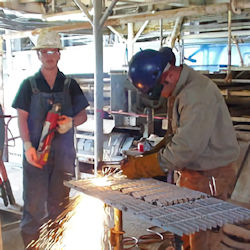Hot Work
Hot work doing any work that involves burning, welding, using fire- or spark-producing tools, or anything that produces a source of ignition.
Dangers of Hot Work
Follow these general best practice control measures below for hot work.
- Do not perform hot work where flammable vapors or combustible materials exist.
- Relocate work and equipment outside of the hazardous areas, when possible.
- Have suitable fire-extinguishing equipment immediately available, in a state of readiness. This equipment may consist of pails of water, buckets of sand, hose, or portable extinguishers, dependent upon the nature and quantity of the combustible material exposed.
- When performing hot work, assign a fire watch to monitor for fire hazards during and after the job.
Fire Watch
A worker designated as the "Fire Watch" must be assigned whenever welding or cutting is performed in any location where a fire greater than minor could occur, or if any of the following conditions are present:
- Appreciable combustible material, in building construction or contents, closer than 35 feet (10.7 m) to the point of operation.
- Appreciable combustibles are more than 35 feet (10.7 m) away but are easily ignited by sparks.
- Wall or floor openings within a 35-foot (10.7 m) radius expose combustible material in adjacent areas including concealed spaces in walls or floors.
- Combustible materials are adjacent to the opposite side of metal partitions, walls, ceilings, or roofs and are likely to be ignited by conduction or radiation.
Fire Watch Duties
The duties and responsibilities of a qualified Fire Watch include:
- They must have fire-extinguishing equipment readily available.
- Train them in how to use fire-extinguishing equipment.
- They must be familiar with facilities for sounding an alarm in the event of fire.
- They must watch for fires in all exposed areas, try to extinguish them only when obviously within the capacity of the equipment available, or otherwise sound the alarm.
- They must maintain a fire watch for at least 30 minutes (to meet OSHA requirements) or 60 minutes (to meet NFPA requirements) after completion of welding or cutting operations, to detect and extinguish possible smoldering fires.
Knowledge Check Choose the best answer for the question.
3-6. To meet OSHA requirements, how long must a fire watch be posted to detect and extinguish possible fires?
You forgot to answer the question!

